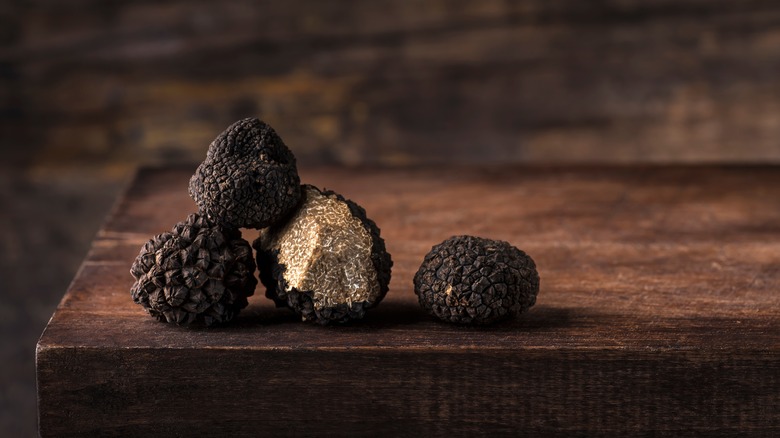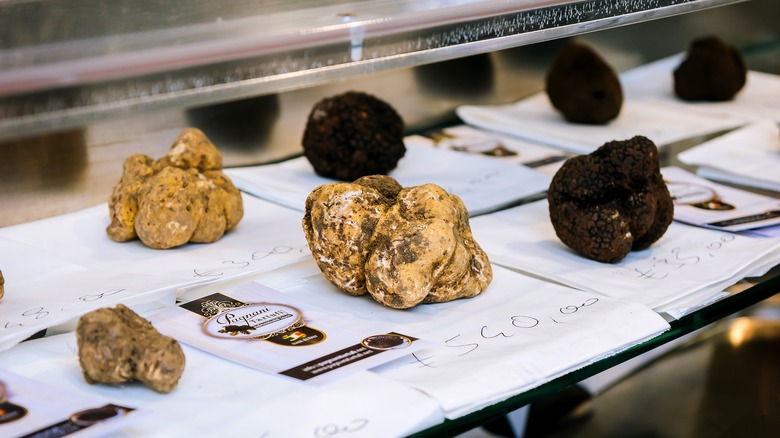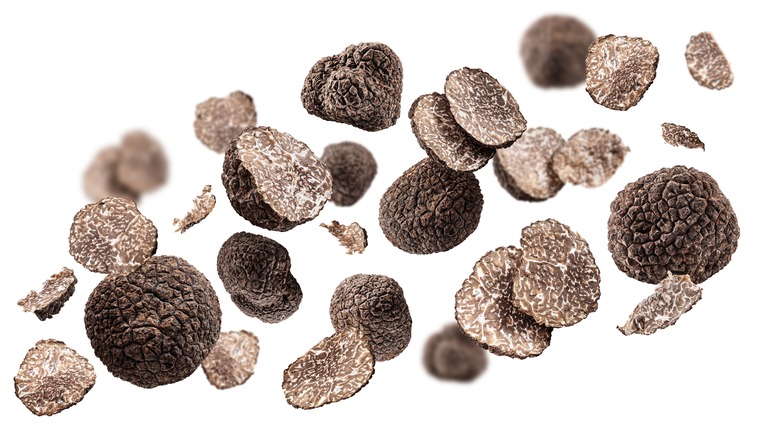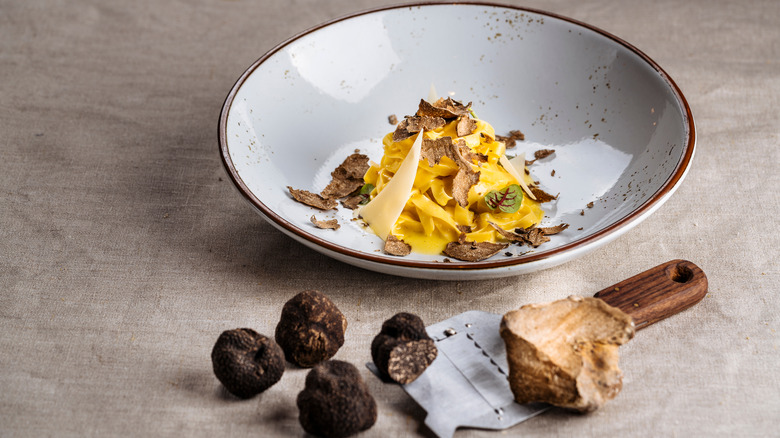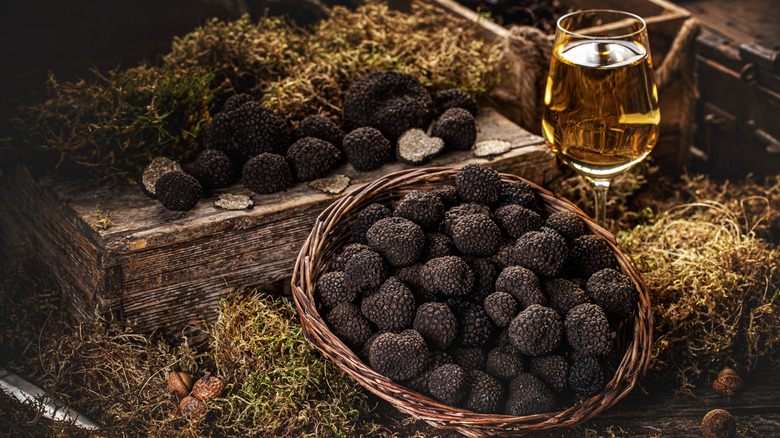What Momofuku's Chef De Cuisine Wants You To Know About Cooking With Truffles - Exclusive
In recent years, truffles have experienced a culinary renaissance. Once a sacred ingredient exclusive to Michelin-star menus, truffles are now more common among home cooks, generally used in the form of truffle butter and truffle oil available online or at your local grocery store. While those forms of truffle flavoring are often intense in their saturated truffle aroma, whole truffles will add an even more decadent flavor and dimension to your cooking.
But working with whole truffles for the first time can seem like a daunting endeavor. Fortunately, we've gathered wisdom from a celebrated chef who is a truffle expert to help guide your culinary journey.
We recently sat down with Momofuku's chef de cuisine of Noodle Bar East Village, Pablo Vidal Saioro for an exclusive interview with Tasting Table to learn about the best ways to use whole truffles at home, starting with procuring the sought-after ingredient and exploring the best practices for cooking with them.
Procuring truffles
To cook with whole truffles at home, your first step is learning how to procure them. One of the most important decisions you'll have to make is whether to purchase black truffles or white truffles. In general, white truffles are significantly more expensive than black truffles, but other differences are worth considering. According to chef Vidal Saioro, "black truffles have more flavor while white truffles have more aroma."
At Momofuku, the question of where to find quality truffles is simplified by the fact that Noodle Bar sources all of its fresh truffles from gourmet food supplier Regalis Foods. The type of truffle currently used in Momofuku's limited edition Truffle Ramen is Perigold truffles, which are black truffles from either Italy or France that are foraged in the winter. During the summer months, chef Vidal Saioro shares that the highest quality truffles are foraged in Chile.
While whole truffles can be purchased online, when possible, chef Vidal Saioro recommends sourcing your truffles in person so that you can differentiate between high-quality and low-quality truffles. When shopping for truffles, he shares: "I look for fragrant, ripe truffles to ensure that they will impart the flavor we need to make a truffle dish special. Low-quality truffles are usually less fragrant and flavorful overall and are on the drier side, like unripe fruit."
Fresh vs. frozen
Depending on where you happen to be located, the current climate, and the parameters of your culinary budget, it can often be difficult to source fresh specialty ingredients. Globally, frozen specialty ingredients have transformed how home cooks can now sample delicacies from different corners of the world by infusing accessibility into the marketplace. While some ingredients don't change their flavor composition when frozen, that is unfortunately not the case with whole truffles.
"The freezing process breaks the cells [down] and [the truffles] become much harder to work with," chef Vidal Saioro explains. Therefore, if you're planning to purchase whole truffles, it's essential to ensure that they were never frozen before they arrived at your local store, as their flavor and intensity will be significantly altered.
But don't be discouraged if the fresh whole truffles you encounter don't smell as strongly as the truffle butter or truffle oil that you may be used to cooking with. That doesn't mean the truffles aren't high-quality. "When you have fresh truffles, [the aroma] is not as strong," chef Vidal Saioro shares.
Activating the truffle
Once you've procured your fresh whole truffles, it's time to cook with them. For home chefs with experience using hearty pours of truffle oil or thick pats of truffle butter, working with fresh whole truffles can be confusing. How should you go about adding fresh truffle flavor to your recipe? According to chef Vidal Saioro, the best way to incorporate fresh truffles into any dish is to add them at the end of the cooking process.
"Truffles lose their flavor if high temperatures are applied, so it's best to use them as a finishing ingredient or in low-temperature cooking," he explains. The flavor of the truffle activates when it comes into contact with heat, which is why truffles are less often found in cold dishes where their nuanced dimension would be less appreciated.
In Momofuku's Truffle Ramen, instead of shaving black truffles on top of the steaming broth, chef Vidal Saioro uses a Microplane so that the pieces of truffle are more densely concentrated and have an opportunity to melt into the ramen. That decision spreads out the truffle flavor, somewhat similarly in concept to using a diluted form of truffle such as an oil or butter because it ensures that truffle flavor will be present in every bite.
Don't overpower the truffle flavor
It can be tempting to want to add several different layers of flavor to a dish when you're cooking for a special occasion or using specialty ingredients, but chef Vidal Saioro believes that whenever you're working with fresh truffles, "the focus [should be] on the truffle itself." At Momofuku Noodle Bar, this philosophy is on display within the Truffle Ramen, which was designed with a vegetarian broth so that the dish would be centered entirely on the truffle flavor rather than on an overpowering protein like beef or pork.
Think about using whole truffles as the centerpiece of whichever dish you create. All of the supplementary ingredients that you use in the recipe should be in service of emphasizing the truffle flavor rather than attempting to compete with it. Because whole fresh truffles are more delicate than their synthetic or diluted counterparts in oils and butter, it's essential not to overcomplicate your dish to allow that nuanced truffle flavor to be fully appreciated.
